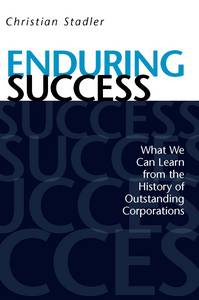 I recently came across a very interesting book which follows in the tradition of Arie de Geus‘ book “The living company” or the book “Built to last” from Jim Collins and Jerry Porras.
I recently came across a very interesting book which follows in the tradition of Arie de Geus‘ book “The living company” or the book “Built to last” from Jim Collins and Jerry Porras.
Like Ariel de Geus, Christian Stadler wanted to find out what long-lived companies (with an age above 100 years) do differently compared with their short-lived peers. In his book “Enduring Success” he and his team looked into the history of such organizations by using archival data as well as interviewing CEOs and executive board members.
His vantage point of long-lived companies brings a new and interesting perspective to organizational future orientation. While we generally ask what any company can do to adapt to changes in the environment and to sustain their competitive advantage, Christian Stadler looks the other way from the perspective of companies that have successfully endured changes in their environment. Thus these two perspectives can be seen as two sides of one coin.
The sample of his study consisted of 9 companies that were chosen from the Fortune 500 companies by filtering first by age, than sufficient success and than by choosing a top performing company and within the same industry at least one comparative case.
The primary result from Christian Stadlers’ analysis are a set of five principles, that companies seeking longevity can be advised to follow:
- Exploit before you explore
- Be conservative in and beyond your finance
- Remember and share both mistakes and triumphs
- Diversify into related businesses
- Change in culturally sensible ways
 While these recommendations might look simplistic, Christian Stadler makes a good job in backing up his claims with qualitative and quantitative data. As he used historical data and observed his case study companies over a long period, he is not able to show how successful decisions were taken and can thus not give recommendations how companies can manage the adaptation process on a micro level. This would need a different research approach as it is followed by the strategy-as-practice school. But his book provides plenty of interesting and sometimes counter-intuitive insights into the successful life of the industry icons that have remained successful over a long period of time.
While these recommendations might look simplistic, Christian Stadler makes a good job in backing up his claims with qualitative and quantitative data. As he used historical data and observed his case study companies over a long period, he is not able to show how successful decisions were taken and can thus not give recommendations how companies can manage the adaptation process on a micro level. This would need a different research approach as it is followed by the strategy-as-practice school. But his book provides plenty of interesting and sometimes counter-intuitive insights into the successful life of the industry icons that have remained successful over a long period of time.
For more information on Christian Stadlers work you can visit his blog and check out his articles in Harvard Business Review or in Long Range Planning, in the latter one he also explores the leadership aspect of sailing through changing times.